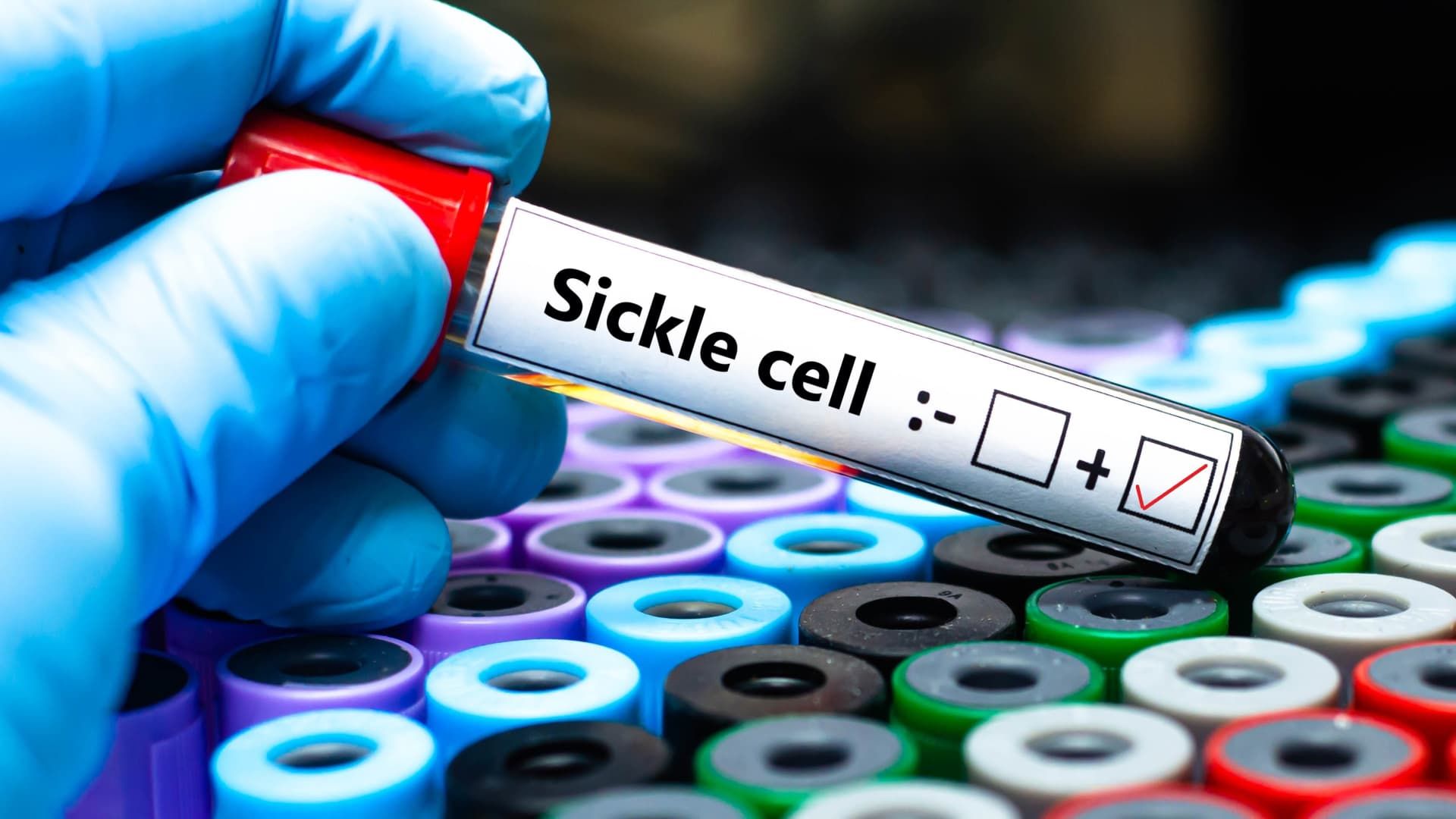Patient's blood sample tested positive for sickle cell anemia.
Kitsawet Saethao | Stock | fake images
The approval of two gene therapies to treat sickle cell anemia has given hope to patients suffering from this debilitating disease, which overwhelmingly affects Blacks and people of color.
Health officials now face the challenge of finding a way to provide equitable access to expensive treatments.
The paralyzing episodes of pain caused by the genetic blood disorder make life unpredictable for patients like Michael Goodwin. Sickle cell anemia forced him to leave his job and, at times, estranged him from his family.
“Sometimes I can be in the hospital 20 days a month,” Goodwin, 36, said. “I've been in the hospital a lot more as I've gotten older, which hurts me because I have a child now and I'm married.”
Still, he's hesitant to try the new gene therapies all at once because they require months of intensive medical preparation, including chemotherapy, to prepare patients' bone marrow stem cells for extraction and gene editing.
Goodwin is also concerned about the cost. Vertex Pharmaceuticals'Casgevy gene therapy is listed at $2.2 million, while Blue Bird BiographyThe Lyfgenia treatment costs $3.1 million.
“I do have insurance, but… I already have medical bills,” he said.
The therapies were hailed as a long-awaited breakthrough in treating the disease when they were approved in December. But obstacles to ensuring equitable access and a lack of infrastructure to administer the nascent treatments have raised questions about how many people will benefit from them.
Goodwin's hesitation to pursue treatment doesn't surprise Dr. Julie Kanter, director of the Adult Sickle Clinic at the University of Alabama at Birmingham.
“My guess is that even if we opened the doors today to everyone receiving this therapy, at most only 10% of individuals affected by sickle cell anemia would want this therapy,” said Kanter, who also serves as president of the Alliance. National Sickle Cell Diseases. Cellular centers. “And even that would be too much for us right now.”
More than 100,000 Americans suffer from sickle cell anemia, according to estimates by the Centers for Disease Control and Prevention, and between 50% and 60% of them are covered by the federal and state Medicaid insurance program.
Kanter said it will take time to ramp up capacity and set up facilities across the country to treat patients on a large scale.
“We really hope that having the National Alliance of Sickle Cell Centers will allow us to strengthen our centers to generally better care for people living with this disease, which is something we haven't been able to do before because cost is an issue,” he said. . saying.
High cost brings new payment model
As they figure out how to increase treatment capacity, state and federal officials are grappling with how to provide access to expensive new treatments to the thousands of patients covered by the Medicaid safety-net program.
“It's giving us the opportunity to respond to people with medical conditions for which there haven't been very satisfactory treatments. But I think the immediate consideration is that the cost is very high. And state budgets simply can't handle that on their own.” said Kate McEvoy, executive director of the National Association of Medicaid Directors.
An analysis from the University of Washington found that at a price of $2 million or less, one-time gene therapy treatments would provide acceptable value, offsetting lifetime medical and quality of life costs for patients with acute sickle cell anemia. Many who suffer from the disease require multiple hospitalizations and blood transfusions, which can leave them unable to work.
But the researchers concluded that a lower price, closer to $1 million, would help ensure greater access.
The Biden administration will begin negotiations in the coming weeks with Vertex and Bluebird Bio for discounts for state Medicaid plans, with payments tied to patients' health outcomes. It is part of the Centers for Medicare and Medicaid Services' Cell and Gene Therapy Access Model, which aims to make it easier to obtain new, high-priced treatments. The approval of sickle cell treatments led the administration to begin implementing the new payment demonstration program a year earlier, starting in January 2025.
“There are probably about 100 therapies in the FDA pipeline at an advanced stage of application…so this is a real-time priority in terms of developing strategies that will bolster the ability of Medicaid programs to cover the treatments.” “McEvoy said.
The direct talks with sickle cell drug makers come as big pharmaceutical companies like merck, Eli Lilly and others are suing the Biden administration over Medicare price negotiations under the Inflation Reduction Act, which began in February. Those talks could lead to much lower price offers on the first 10 drugs selected for negotiation.
But on Vertex's quarterly earnings conference call this month, executives expressed confidence in the negotiation process in this case. They said discussions with individual state Medicaid agencies will help ensure broad access and address long-standing disparities in care in the sickle cell community.
“We are not waiting for demonstration before ensuring access for patients covered by Medicaid,” Steve Arbuckle, Vertex executive vice president and chief operating officer, told analysts. “If you look at Casgevy's profile, it's so incredibly strong that we're actually talking about an outcomes-based agreement that looks at whether a very, very small number of patients may not respond.”
Entrepreneurs are taking note
Private employer health plans are also grappling with how to pay for a growing number of novel treatments with seven-figure prices, said Morgan Health CEO Dan Mendelson, whose firm focuses on on-site health programs. job.
“Many employers look at cell and gene therapies, look at the costs, and exclude them from their benefits. They know the therapies are valuable,” Mendelson said. But for smaller companies, “one case could exceed the cost of insuring an entire population over the course of a year and the employer doesn't even know if the employee will stay.”
Morgan Health is exploring new risk-sharing payment models that could help small and medium-sized businesses cover the rising costs of specialty treatments coming to market.
Goodwin is covered by his wife's employer's health insurance. He has not explored what type of coverage his plan will provide for the new sickle cell treatments, because he is not yet sure if they are right for him.
“If they could guarantee me the outcome, that I wouldn't have sickle cell anemia… I would do it in a heartbeat. In a heartbeat,” he said.
In addition to payment discussions, Vertex and Bluebird Bio are taking steps to educate physicians and patient communities about the benefits of their new treatments.
Vertex expects its first commercial patient to begin treatment in the coming weeks. Bluebird said it anticipated its first patient would start Lyfgenia in the first trimester.












